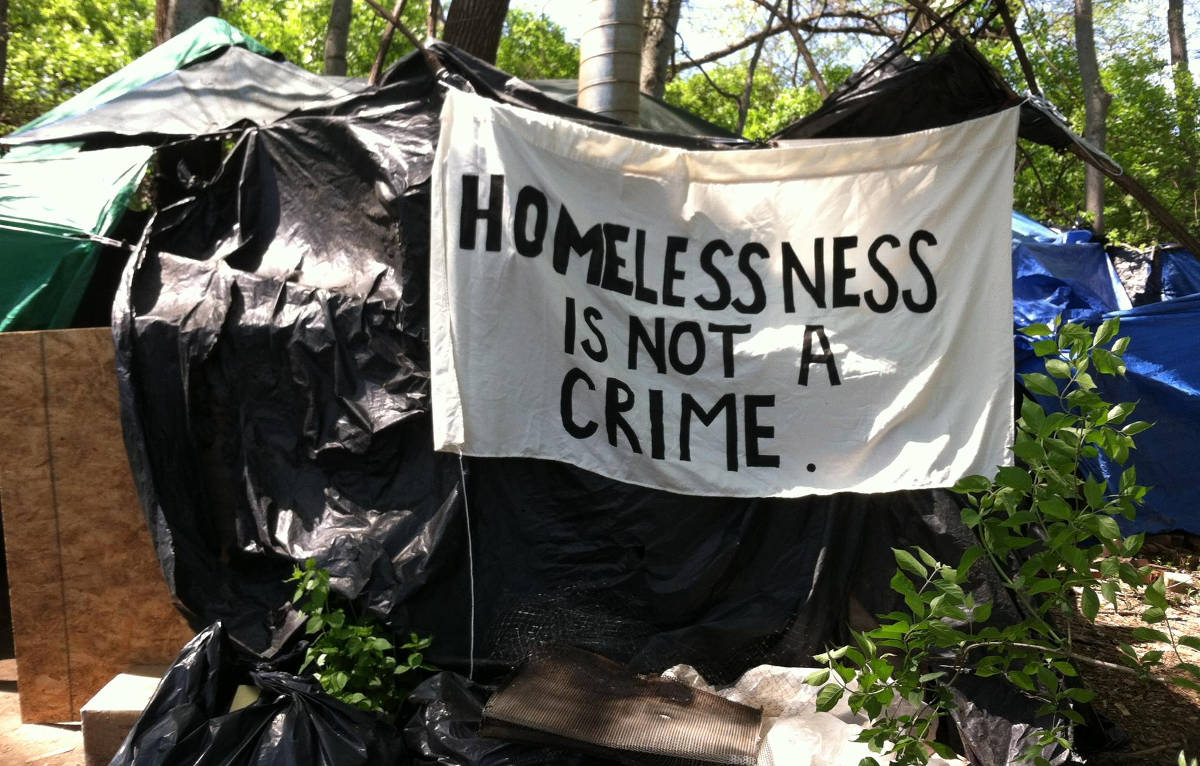The Criminalization of Homelessness
The homeless community has been pushed into a corner and is continuously being punished for simply being present in public spaces when they have no other alternatives. In many American cities, the supply of affordable housing and emergency shelter spaces have been tremendously disproportionate to the thousands of people left to survive outdoors. However, many cities have decided to criminalize them for demonstrating what any human being would do in order to live.
The National Law Center conducted a survey in 187 cities, both documenting the number and type of municipal codes criminalizing the homeless people on their life-sustaining behaviors. These common targeted laws include the prohibiting of “camping” in public, sleeping in public or in private vehicles, begging in public, loitering in public, sitting or lying down in public, the sharing of food, and the list goes on. As opposed to protecting public interest as the laws were established to objectively do, they are costly to taxpayers—state and local budgets are already at it’s their limits, resulting in funding being pulled from taxpayers’ pockets. In addition, criminalization laws have been concluded to be ineffective. The laws only incarcerate homeless people temporarily. Once they return to their communities, the situation has not changed; they are still left with nowhere to go. Most importantly such laws violate the civil and human rights of homeless people and fail to address the core causes of homelessness.
A more effective way to reduce the national homeless crisis is replacing criminalization laws with actual constructive solutions. The Law Center recommends policies consisting of the federal government being more involved in the prevention of homelessness. They should actively work to end practices that criminalize basic human behavior from homeless people and adjust the funding to be allotted towards constructive alternatives than those that criminalize homelessness. The Law Center also suggests the federal government should invest in affordable housing to close the gap between available spaces and the human need to end homelessness. There are better, sensible, cost-effective, and humane solutions to homelessness that are already being implemented in a number of cities now.
In Miami-Dade County, Florida, they have dedicated funding for homeless services with its Homeless and Domestic Violence Tax. The 1% tax collected on food and beverages helps fund the Board of County Commissioners to monitor agencies that are contracted to provide housing and services for homeless people. Salt Lake City, Utah reduced their homelessness rate by 74% with the State Homeless Coordinating Committee and their 10-year plan to end chronic homelessness. Their plan utilizes the Homeless First model and created a streamlined process to efficiently assess a homeless person's needs and eligibility for existing housing opportunities, reducing the wait time for services they demand. These two examples demonstrate that there are other options to curbing the homeless rate.
For more information click here.
Author: Mae Dang
(Source: kairoscenter.org)
The National Law Center conducted a survey in 187 cities, both documenting the number and type of municipal codes criminalizing the homeless people on their life-sustaining behaviors. These common targeted laws include the prohibiting of “camping” in public, sleeping in public or in private vehicles, begging in public, loitering in public, sitting or lying down in public, the sharing of food, and the list goes on. As opposed to protecting public interest as the laws were established to objectively do, they are costly to taxpayers—state and local budgets are already at it’s their limits, resulting in funding being pulled from taxpayers’ pockets. In addition, criminalization laws have been concluded to be ineffective. The laws only incarcerate homeless people temporarily. Once they return to their communities, the situation has not changed; they are still left with nowhere to go. Most importantly such laws violate the civil and human rights of homeless people and fail to address the core causes of homelessness.
A more effective way to reduce the national homeless crisis is replacing criminalization laws with actual constructive solutions. The Law Center recommends policies consisting of the federal government being more involved in the prevention of homelessness. They should actively work to end practices that criminalize basic human behavior from homeless people and adjust the funding to be allotted towards constructive alternatives than those that criminalize homelessness. The Law Center also suggests the federal government should invest in affordable housing to close the gap between available spaces and the human need to end homelessness. There are better, sensible, cost-effective, and humane solutions to homelessness that are already being implemented in a number of cities now.
In Miami-Dade County, Florida, they have dedicated funding for homeless services with its Homeless and Domestic Violence Tax. The 1% tax collected on food and beverages helps fund the Board of County Commissioners to monitor agencies that are contracted to provide housing and services for homeless people. Salt Lake City, Utah reduced their homelessness rate by 74% with the State Homeless Coordinating Committee and their 10-year plan to end chronic homelessness. Their plan utilizes the Homeless First model and created a streamlined process to efficiently assess a homeless person's needs and eligibility for existing housing opportunities, reducing the wait time for services they demand. These two examples demonstrate that there are other options to curbing the homeless rate.
For more information click here.
Author: Mae Dang



Comments
Post a Comment